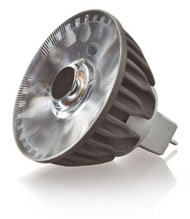Soraa Inc of Fremont, CA, USA, which develops solid-state lighting technology built on ‘GaN on GaN’ (gallium nitride on gallium nitride) substrates, has launched 230V GU10 and 100V E11 versions of its new full-spectrum VIVID 2 and PREMIUM 2 LED MR16 lamps (replacements for 65-watt and 75-watt halogen lamps).
Enabled by Soraa’s GaN-on-GaN LEDs, the new LED MR16 lamps deliver what is claimed to be the industry's highest light output while rendering vivid colors, richer reds and whiter whites. The latest launch follows the announcement of the availability of Soraa’s new lamp line for the North American market.

Picture: Soraa’s LED MR16 lamp.
“We now have 65-75W-equivalent lamps that produce full-visible-spectrum light and consume 80-85% less energy,” says president & chief operating officer Dr Tom Caulfield. “We have just scratched the surface in terms of performance gains from our GaN-on-GaN LED technology,” he believes.
Most LED lamps currently available are based on LEDs made by depositing GaN on foreign substrates such as sapphire, silicon carbide (SiC) or silicon, so they have high crystal defect densities that limit the amount of current densities they can handle, limiting the amount of light they emit per unit area. These high defect densities also constrain the LEDs to much lower temperatures in order to operate reliably, says Soraa. Both these limitations are amplified when these LEDs are used in a small form factor like an MR16 lamp, which is frequently installed in constrained or enclosed fixtures, and is used in applications that require very high light output, adds the firm. The lamps that use these LEDs have to make compensating design choices like using multiple LED light sources to generate the required amount of light, and active cooling mechanisms to keep the LEDs within their operating temperature range.
In contrast, the VIVID 2 and PREMIUM 2 lamps’ GaN-on-GaN LED technology leverages the 1000x lower crystal defect density of the native substrate, emitting substantially more light and allowing reliable operation at much higher temperatures, claims Soraa. This enables a simple and robust MR16 lamp design that uses a single LED light source and a simple heatsink, while producing 65-75W-halogen-equivalent light output and operating reliably at lamp temperatures of up to 120°C (a requirement for use in the most constrained fixtures).
“Smaller-form-factor, high-output LED MR16 lamps will now replace larger lamp types like PARs,” believes Caulfield.
The VIVID 2 LED MR16 lamp has a color rendering index (CRI) of 95 and R9 of 95 and is available in a complete suite of beam angles, color temperatures and lumen outputs. The PREMIUM 2 LED MR16 lamp has a CRI of 80 and is available in multiple beam angles and color temperatures.





